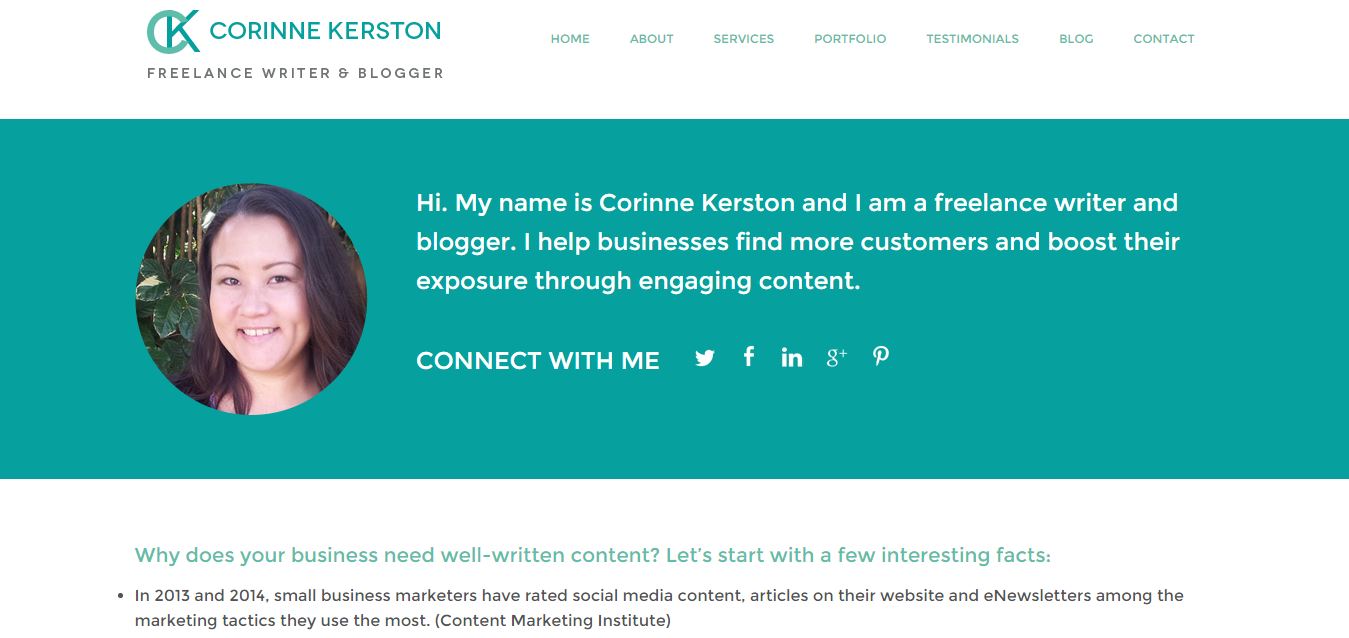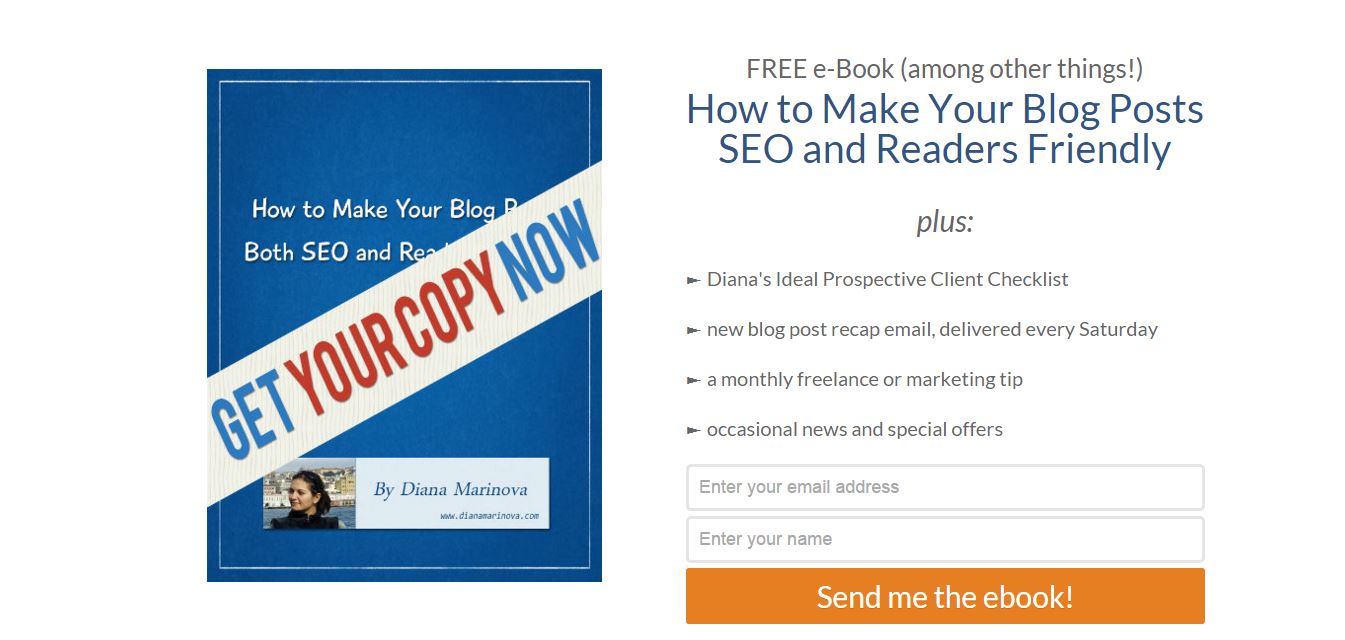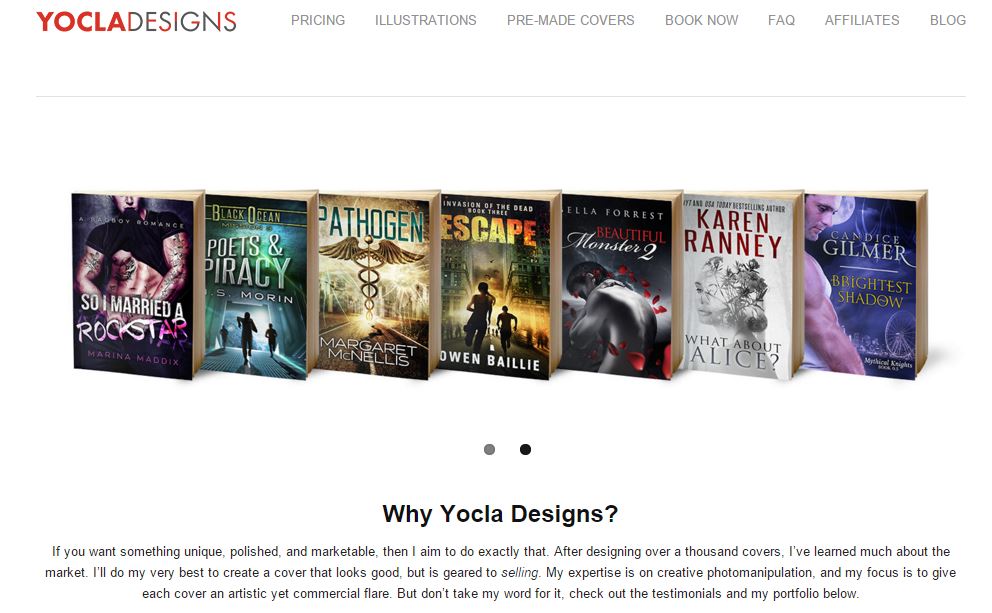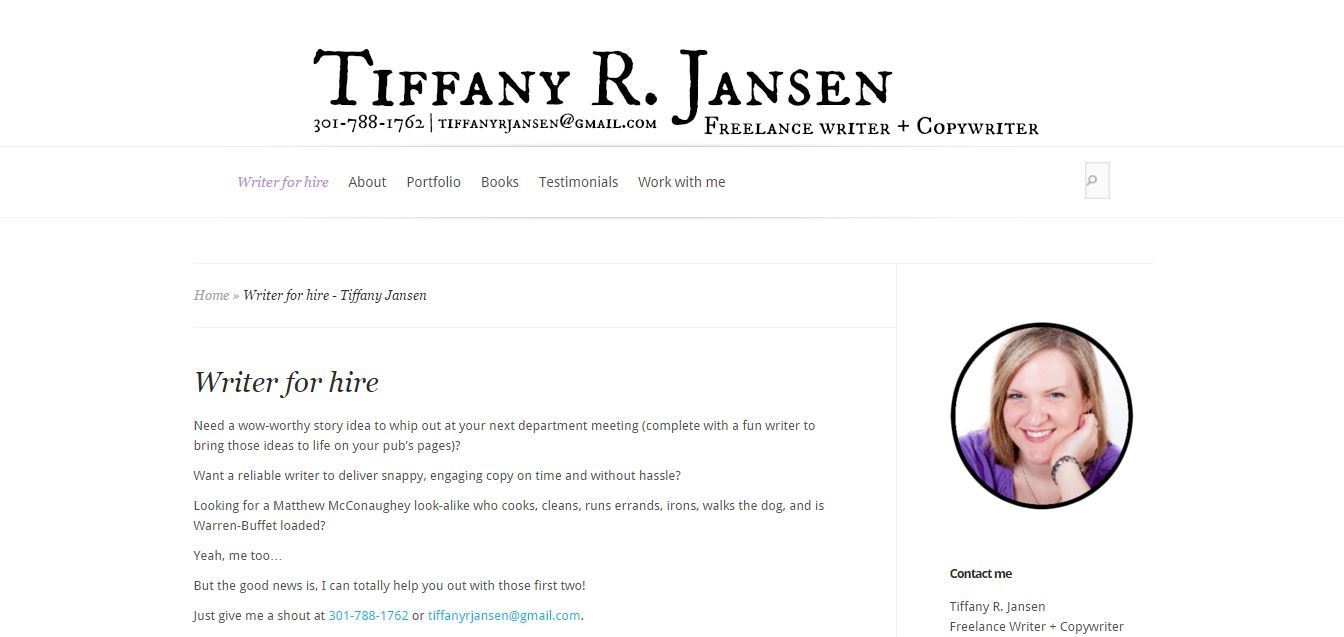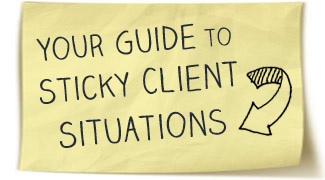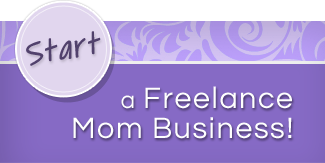
It’s undisputed. If you’re running a business, you need a website.
As a freelancer, this rule applies to you, too.
According to a survey by Makealivingwriting.com, 40 percent of freelance writers don’t even have a website (and this is just one profession within the whole freelance arena).
But simply having a website doesn’t guarantee you’ll sell your expertise with it. You have to have a well-planned strategy.
Start by incorporating these 10 elements on your website if you plan to sell your expertise.
1. A Professional Design
Image via CorinneKerston.com
Although it may seem unfair, web visitors will judge your business based on your website’s design. If they don’t trust your site off the bat, you’re losing sales.
In a study titled Trust and Mistrust of Online Health Sites, researchers found that website mistrust is attributed to web design 94 percent of the time while content is only considered 6 percent of the time.
According to the study, site aspects that devalue the brand include:
- Inappropriate website name
- Busy layout
- Complex navigation
- Pop-up alerts
- Boring design
- Too much text
- Small print (Social Triggers says size 14 font is the new size 12, but don’t be afraid to kick it up to size 16!)
Another factor that affects site trust is page speed. According to Conversion XL, it’s best for your pages to load in under three seconds, but you’re doing okay if your page loads in under 7 seconds. Anything more than 10 seconds and you’ll start losing a noticeable amount of money—such as from people abandoning the site.
For a professional-looking design people can put trust in, opt for a self-hosted WordPress site if you plan to do it yourself, or hire a professional designer for a custom design.
2. A Clear Course of Action
KISSmetrics reports on a study that showed that when presented with too many choices, users will become overwhelmed and won’t make a choice! In this study, researchers set out to sell jam. One group offered 24 flavors while another offered just six.
While more people stopped to sample the jams when 24 options were available—60 percent compared to 40 percent—the researchers actually made more sales when only six flavors were offered. Thirty percent of people who sampled the six flavors purchased while only three percent who sampled the 24 flavors purchased.
This research shows that if you give people too many choices, they won’t take action. The same can be said about your website. Including several equally prominent calls-to-action can become overwhelming. Instead, define exactly what you want prospects to do.
Examples include:
- Hire Me
- Contact Me
- Shop Now
In the following example, freelance copywriter Francesca Nicasio uses the phrase “Let’s Talk” and places it prominently to get prospects to contact her.
Image via CredibleCopywriting.net
Once you have prospects hooked with a clear call-to-action, include instructions on the next steps, such as:
- Start with your free consultation
- Get your first month free
- Redeem your coupon code
- Email me at [email protected]
Important: Don’t send prospects off your site before making a sale. Inviting them to “visit my blog” before encouraging them to hire you won’t result in sales.
3. A Portfolio
Clients want to see what you’re capable of. A portfolio highlights your past experience and proves your skills, which can establish trust in your brand and make you more money. As Brennan Dunn explains:
When a client feels that someone is particularly high risk . . . the default position is to put less money on the table . . . So the obvious converse is that if you can prove that you are a very safe bet, and that hiring you will almost certainly yield the business results they’re looking for, pockets will deepen.
Here are some examples of what you might include in your portfolio:
- Web Designer: Screen shots and links to sites you’ve designed.
- Writer: Links to your published works on the web.
- Social Media Marketer: Screen shots of successful campaigns.
- Photographer: Images you’ve taken of client sessions.
Although these suggestions are some of the more obvious ones, don’t be afraid to get creative with your portfolio. A freelance dog trainer, for instance, might showcase videos of a successful session.
Take a look at this example from seamstress Amy Nicole. Although she doesn’t offer a digital product or service, she’s still able to capture prospects’ attention and showcase her skills through images of her clothes.
Image via AmyNicoleStudio.com
4. Testimonials and Social Proof
Image via KristiHines.com
Another way to establish trust and to prove that your product or service is worth investing in is through client testimonials and social proof. As Rachel Clapp Miller points out in a HubSpot article:
Providing proof that your solution does what it says it’s going to do, (1) strengthens your sales message and (2) makes a customer feel more comfortable about doing business with you.
Research from TechValidate found that the majority of B2B marketers—54 percent—agreed that content sourced from existing customers was “extremely effective” in convincing prospects of a brand’s value. This includes testimonials, case studies, and customer videos.
Other types of social proof include:
- Numbers: How many clients have you served or projects have you worked on?
- Social following: How many people follow your business on Twitter?
- Ratings: How many reviews does your eBook have on Amazon, and what’s the average star rating?
- Expert mentions: Have you been quoted in an article on an authority website?
According to a CompUSA and iPerceptions study as reported by Search Engine Journal, 63 percent of customers are more likely to purchase from a site with product ratings and reviews.
5. A Lead Magnet and Email List
Image via DianaMarinova.com
Email marketing is one of the best ways to attract leads and drive sales. That’s why you need to have a way of gathering emails on your site along with an incentive to join your email list.
But don’t take my word for it. In the 2015 State of Marketing Report released by Salesforce Marketing Cloud, researchers found that:
- 60 percent of marketers agree that email is a “critical enabler of products and services.”
- 20 percent of marketers say their “primary revenue source is directly linked to email operations.”
- 5 percent of U.S. Internet users prefer to communicate with businesses through email.
Start with a lead magnet, which is essentially a bribe to get people to sign up for your list. Examples include a free eBook or special discount. Then, gather emails using strategically placed sign-up boxes, and finally, use your newsletter to offer value while promoting your products or services to drive sales.
6. A Description of Your Services
Image via EmilySuess.com
Too often freelancers describe themselves as a “writer” or “designer” or “photographer” and leave it at that. To attract your ideal client, be sure to describe what you do in detail.
For example, writers offer varying services from press releases to blog posts to grant proposals. A photographer who specializes in custom photo shoots for book covers would offer unique value to self-published authors over a family portrait photographer.
According to Shopify:
When it comes to online sales and customer conversion, connecting with your potential customers and describing your products persuasively is one of the most important parts of selling online.
That’s because after your product photo, your product description is the information people turn to when trying to make a buying decision.
Although your “product” may not be a physical good, people will still look to your copy to make a decision on whether to work with you or not.
When describing your services, you might also consider including pricing. As Doug Kirk points out on HubSpot, buyers will search for pricing details, and if they don’t find them on your website, they’re going to find them on your competitor’s, which will cost you sales.
He also suggests that including pricing details is good for SEO, which can further drive sales, because when few people are listing their pricing, you end up with little competition for a highly searched term, such as “freelance copywriter rates.”
7. A Unique Selling Point (USP)
A unique selling point or unique selling proposition (USP) is defined by Entrepreneur.com as:
The factor or consideration presented by a seller as the reason that one product or service is different from and better than that of the competition.
A USP sets you apart from other people in your industry. It makes people remember you and feel compelled to buy from you.
For some businesses, their USP may be all about low prices and high value. A freelancer might set themselves apart by emphasizing their years of experience or related degree. Freelance artists of all sorts can highlight what makes their personal style unique to drive interest.
Let’s take an example from freelance book cover artist Clarissa Yeo.
Image via YoclaDesigns.com
She specifically points out “My expertise is on creative photomanipulation.” This shows potential clients that she doesn’t just take a stock photo and overlay the text like many cover designers do, and that sets her apart without degrading other designers.
Ask yourself: What makes my business/product different? Once you pinpoint that, prospects will notice it, too.
8. Client-Focused Copy
Too many websites talk about “me, me, me.” However, as marketing gurus Neil Patel and Joseph Putnam point out, “an important rule for writing better copy is to not focus your copy on yourself.” They go on to say, “The secret is that you can write about yourself so long as it’s in the context of providing value for your customers.”
This essential rule of copywriting calls for you to frame your content to be about “you”—your potential client. Tell them what you do by showing them how you can help them reach their goals through “you” language.
According to Susan Gunelius on Forbes, 80 percent of your copy should be written in second person (i.e. “you”) while only 20 percent should be written in first person (i.e. “me” or “we”).
This goes for your About page as well. Although this page is about you, remember to show prospects the benefit of that information by relating it to their goals.
Here’s an example from freelance copywriter and social media strategist Anastasia Sproull.
Image via AnastasiaSproull.com
Doesn’t this just pull you in? Anastasia goes on to say “That’s where I come in” before highlighting why she’s the right girl for the job.
9. A Headshot
According to Stanford Web Credibility Research, showing that there’s a real person behind your website is one of the best ways to establish online credibility. As a freelancer, you can immediately boost credibility by uploading a headshot to your website.
Here’s just one example from freelance cartoonist Jaime Sale.
Image via JaimeSale-Cartoonist.com
At the very least, include a headshot on your About page—where prospects would expect to find it. However, it doesn’t hurt to establish credibility across your site by including photos on the homepage or in your sidebar.
Be cautious of the headshot you choose. A photo taken at a bar might damage your credibility more than it builds it up. Choose a photo that represents your business—so it can be silly, but only if that’s how you want to portray your brand.
For more information on how to take a great headshot, check out these tips from Contently.
10. Contact Information
It sounds obvious to include your contact information, but too many people forget to add it to their site or make it too hard to find. According to the Content Marketing Institute, 55 percent of B2B buyers agree that lack of contact information reduces a vendor’s credibility, and another 37 percent say it wastes their time.
So what type of contact information should you include? That depends on your and your prospects’ preferred means of contact. For example, some freelancers might include an address and phone number while others don’t require that information to get in touch with prospects. Other options include your email address, social media profile links, and Skype username. You can also include a contact form or chat box.
At the very least, your contact information should be easy to find, such as in your site’s sidebar or in a contact tab. Or, do as freelance writer Tiffany Jansen has done here and keep your contact info in your header.
Image via TiffanyRJansen.com
Now that you’re equipped with all these ideas, it’s time to tweak your website!
Download our printable checklist to keep beside you while you update your site.
Which tip listed here will you tackle first?
